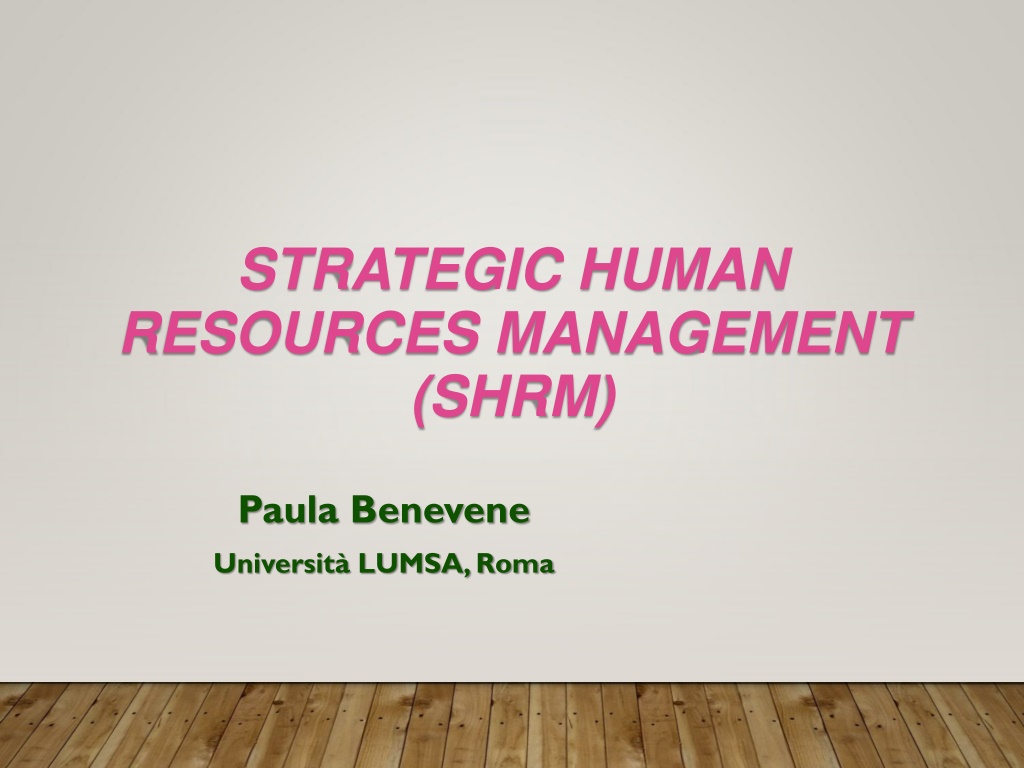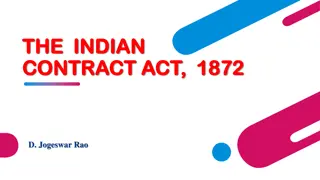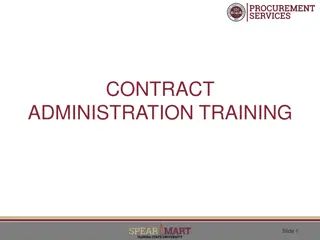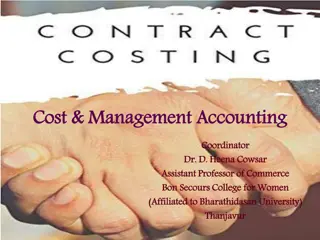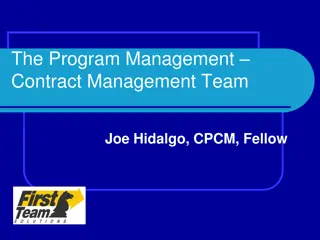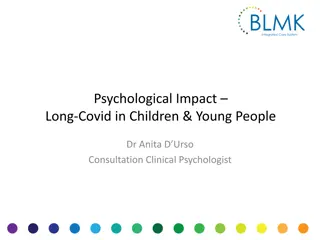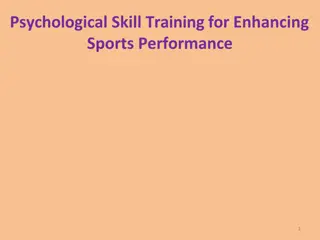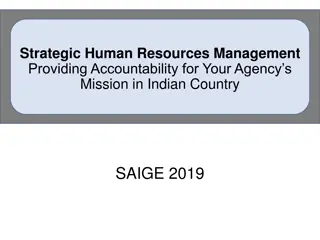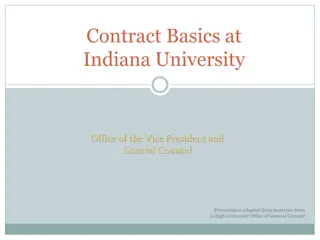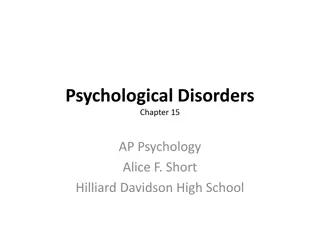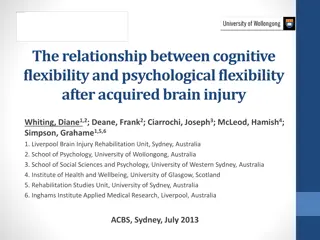Understanding Strategic Human Resources Management and the Psychological Contract
Strategic Human Resource Management (SHRM) plays a crucial role in aligning organizational objectives with human resource activities. The integration of people into strategic goals and effective employee management are key challenges. The Psychological Contract, based on mutual expectations between organizations and employees, influences behaviors like organizational commitment and work engagement. Strong psychological contracts positively impact organizational outcomes while minimizing counterproductive behaviors.
Download Presentation

Please find below an Image/Link to download the presentation.
The content on the website is provided AS IS for your information and personal use only. It may not be sold, licensed, or shared on other websites without obtaining consent from the author. Download presentation by click this link. If you encounter any issues during the download, it is possible that the publisher has removed the file from their server.
E N D
Presentation Transcript
STRATEGIC HUMAN RESOURCES MANAGEMENT (SHRM) Paula Benevene Universit LUMSA, Roma
STRATEGIC HUMAN RESOURCES MANAGEMENT In order for an organization to achieve its objectives, its members must know, understand and share the values, objectives and mission of the organization itself. Strategic Human Resource Management (SHRM) is a planned model of HRM activities aimed at making the organization achieve its objectives The challenges to be faced are mainly two: The integration of people in the strategic objectives of the organization (alignment); Effective and efficient management of employees.
STRATEGIC HUMAN RESOURCE MANAGEMENT (SHRM) SHRM is such only if it enables the organization to achieve its objectives; SHRM implies the planning of human resource development activities aimed at achieving the organization's objectives; SHRM implies alignment between corporate strategy and HR strategy; When it is limited to the management of daily activities,it may not have any strategic importance.
THE PSYCHOLOGICAL CONTRACT In the professional field there are: Exchange relations, Hierarchical relationships, and Social and psychological relationships. The legal employment contract has a technical-legal nature but does not exhaust the relationship between the employee and the organization; The psychological contract is a fundamental junction of the SHRM; it is based on the mutual expectations between the organization and the employee.
THE PSYCHOLOGICAL CONTRACT "It is the inner disposition to fulfill a technical-legal obligation or to live the relationship with a spirit of collaboration, trust and a strong commitment to the expectations, implicit and explicit, formal and informal, which are at the basis of the relationship between the employees and the organization; these expectations must find a mutually satisfactory answers (Costa and Gianechini,2009).
THE PSYCHOLOGICAL CONTRACT When the psychological contract is strong it is positively linked to: Organizational citizenship behaviors; Organizational commitment; Work engagement. And it is negatively linked to: Counterproductive behavior in the workplace; Disruptive behavior functioning of the organization. behaviors that interfere with the
THE OBLIGATIONS OF THE WORKER (COSTA E GIANECHINI, 2009) Protect the image of the company; Work in a team; Share the organization's goals; Offer adequate professional performance; Be reliable; Take responsibility; Respect colleagues; Do not help the competition; Be willing to improve.
THE OBLIGATIONS OF THE ORGANIZATION Provide training and development of professionalism; Offer career progression opportunities; Fair and proportionate remuneration; Ensure positive relationships management of relationships in the workplace; Equity of treatment; Safety in the workplace; Acknowledgment of the results obtained. with managers and positive
WORK ENGAGEMENT Work engagement: the opposite of burnout, it is a positive state of mind and satisfaction with one's work characterized by vigor, dedication and immersion (Schaufeli,Salanova,Gonzalez-Rom & Bakker,2002). More than a specific and momentary condition, it refers to a more persistent cognitive-affective state, not focused exclusively on a particular object,event or situation (Schaufeli et al.,2002).
DIMENSIONS OF WORK ENGAGEMENT Vigor refers to high levels of energy and ability to recover, willingness to invest in one's work, not to tire easily and perseverance in the face of difficulties; Dedication refers to a high involvement in one's work, combined with the manifestation of a feeling of enthusiasm,pride,self-denial and devotion to work; Absorption occurs when you are totally immersed and concentrated in work, time passes quickly and you have difficulty to interrupt what you are doing, due to the strong doses of effort and concentration experienced.
BACKGROUND TO WORK ENGAGEMENT Personal resources: self-efficacy and the ability to recover quickly after a busy day (Sonnentag,2003). Work resources: autonomy, variety of tasks, the possibility of receiving adequate feedback on one's work and social support from colleagues and superiors (Salanova,Agut and Peir ,2005;Schaufeli and Bakker,2004).
CONSEQUENCES OF WORK ENGAGEMENT Individual level: reduced levels of nervous tension and depression, fewer psychosomatic disorders, lower absenteeism, greater socialisation and adaptation to the organisation, increased motivation and satisfaction, higher performance and commitment to tasks; Interpersonal level: better relationships with colleagues and clients; engaged workers are more proactive, take initiative in their work and tend to strive for excellence: this allows them to receive positive feedback from supervisors, as well as from their clients/users; Organisational level: reduction of complaints resulting from job stress, increased likelihood of retaining competent people within the organisation.
WHAT ARE THE CONSEQUENCES OF LOW ENGAGEMENT? Quali sono le conseguenze della mancanza di impegno?
BURNOUT VERSUS WORK ENGAGEMENT Maslach and Leiter (1997) consider burnout and engagement as opposite poles of the same continuum: meaningful, important and challenging work becomes unpleasant, unrewarding and meaningless; energy turns into exhaustion,involvement into cynicism: efficacy into ineffectiveness (Maslach et al.,2001).
BURNOUT VERSUS WORK ENGAGEMENT BURNOUT Dimensions WORK ENGAGEMENT Overload of work Workload Sustainable workload Lack of control Control Capacity/possibility to choose and control Insufficient recognition, lack of incentives Isolation Recognition Recognition, rewards, incentives Social integration Feeling of social integration Fairness, justice Significance of the work Lack of fairness Conflict of values Fairness Values
ORGANIZATIONAL COMMITMENT It is the link between a worker and his own organization that makes him less likely to voluntarily abandon the latter (Meyer andAllen,1990). It is a psychological state that binds the employee to the organization (Meyer &Allen,1997,p.23). It has three dimensions: Affective commitment; Normative commitment; Continuance commitment
ORGANIZATIONAL COMMITMENT Affective commitment is the emotional attachment, identification and personal involvement that you feel for the organization you work for; as a result, the workers continue to remain with this organization because it is their will; Normative commitment is the feeling of moral obligation, of responsibility, which leads workers to remain in their organization because they feel it is their duty; Continuance commitment is linked to the perception of the costs and difficulties that one would experience after leaving one's organization, and leads people to stay and work for it because they feel compelled to do so.
ORGANIZATIONAL CITIZENSHIP Organ (1988) defines organizational citizenship behaviors as those individual, discretionary behaviors, not directly or explicitly recognized by the formal recognition system, which overall favor the effective functioning of the organization. Two dimensions are distinguished in the construct: o altruism refers to behaviors carried out in favor of specific people in the organization; o compliance, on the other hand, refers to conducts favorable to the organization in general (for example,arriving on time).
APPROACHES TO SHRM "Best fit" approach: alignment between corporate strategy and HR strategy. Limits: does not motivations. "Best practice" approach: adoption of practices that have shown in other contexts to make the organization work well. Limits: models external to the organization; managers do not always have full freedom to import and reproduce these models. "Best-process" approach: routinized practices and processes in the organization, aimed at creating a sustainable competitive advantage. Limits: reduced emphasis on the plan that defines organizational objectives. take into account personal implementing integrated and
LINK BETWEEN THE STRATEGIC MANAGEMENT OF HR (SHRM) TO THE STRATEGIC MANAGEMENT OF THE ORGANIZATION Direct connection:of an administrative nature (very limited); One-way connection: the strategic planning team draws up the plan and then notifies the HR manager; Two-way link: strategic management and HR are interdependent; the team informs the HR manager of the choices made and the manager analyzes the implications on HR communicates them to the team, who finalizes the plan,which is communicated to the HR responsible which in turn then takes care of its implementation; Integrated connection: the HR manager participates in the strategic planning team; he is involved in both the design and its implementation.
APPROACHES TO SHRM SHRM is related to knowledge management and knowledge creation; The SHRM must concern the individual, group and organizational level; It is not enough to correct the mistakes of the past.
HUMAN RESOURCE DEVELOPMENT Assessment of training or learning needs; HRD plan drafting; allocation of a budget; drafting of a specific program; assignment of tasks; running the program; evaluation of training efficiency; feedback on the results identification of appropriate actions and possible re-alignment, in relation to the tactical and strategic objectives of the organization.
THE SHRM PLAN MISSION:the starting point ANALYSIS OF THE EXTERNAL ENVIRONMENT: competition analysis; analysis of laws, norms and rules; analysis of technological developments; market trend analysis; economic trend analysis; ANALYSIS OF INTERNAL ENVIRONMENTAL : analysis of resources and analysis of management systems; STRATEGY: identification of appropriate actions and possible re-alignment, in relation to the tactical and strategic objectives of the organization.
CRITICAL FACTORS Consider HR as resources and not as costs; Management convinced of the relevance of HR; Coordination between organizational management and HR management; Training seen as an end in itself; HRD is an important element in the intention to stay and work in the same workplace; Often only workers higher on the hierarchical ladder receive training; In critical times,the training budget is the first to be cut; Confusion between training and learning.
TRAINING TO LEARNING Learning is linked to experience; Learning can be direct or indirect; Maturity is not learning; Learning does not necessarily correspond to a desirable change; The change can take place through planned training interventions or in an informal way (e.g. on-the-job, tutoring, mentoring, coaching, training courses,etc.); It is a process that changes behavior in a stable way; Individual learning takes place in a social context, takes place within a system of company rules,practices and standards.
THE EXPERIENTIAL LEARNING CYCLE OF KOLB ET AL.,1974 Concrete experience (but also case studies, projects, presentation of a problem,etc.); Observation and reflection; Theorizing and conceptualization; Verification and experimentation.
THE EXPERIENTIAL LEARNING CYCLE OF KOLB ET AL.,1974 According to Kolb,learning is a circular process; A multitude of different activities are possible and each of us has a preferred learning style; Learning through experience is more solid but takes more time than traditional courses; Delicacy of the transfer from individual learning to organizational levels; It is necessary to provide adequate times for reflection and for the application of what has been learned.
POSSIBLE OBSTACLES TO LEARNING A subject may not have the tools to analyze a new or different experience; An individual may not have the ability to analyze the situation; Simulated experiences may seem fictitious,artificial,irrelevant; Lack of time to reflect on the experience made.
4 INDIVIDUAL LEARNING STYLES (HONEY E MUMFORD, 1992) Active: They engage in problem solving, brainstorm, accept challenges and get bored when it comes to consolidating learning and results; Thoughtful: They ponder situations before acting, are cautious, gather information before reaching conclusions and acting; Theorists: they create rational schemes, they favor a logical approach to problems; Pragmatic:they implement ideas,techniques and tools to see if they work, experiment through application, impatient in the face of theoretical discussions,are practical and operational.
IS THE ANSWER TO THE PROBLEMS TRAINING OR LEARNING? Performance problems can arise from aspects relating to organizational processes, communication, HR management, leadership, team management, organizational flexibility, organizational culture; In these cases, the training or learning is not successful; The gap between necessary skills and the capacity actually possessed by individuals can be bridged by training or learning; The gap between real and desired returns may not depend on the lack of training.
ORGANIZATIONAL PERFORMANCE Factors affecting organizational performance are: Company structure; Corporate culture; Reward and recognition systems,incentives; Job design; Group processes; Politics and power.
THE ASSESSMENT AND DETECTION OF TRAINING AND LEARNING NEEDS Can be evaluated by: Interviews; Observation; Self evaluation; Assessment center; Psychometric tests; 360 degree feedback; Competence-based learning is particularly widespread because it is considered one of the most effective approaches.
JOB TRAINING ANALYSIS - JTA The analysis of training needs can be developed through: Comprehensive analysis: detailed analysis of every aspect of the job; very long and expensive even if very exhaustive. Analysis of key tasks: analysis of the aspects considered crucial for the quality of work Problem-centered analysis: analysis of the difficulties and criticalities encountered Competence-based analysis: identification of the skills necessary for the professional roles present in the organization
SUCCESS OF SHRM Important variables that contribute to the success of SHRM are: Organizational structure; Task design (definition of tasks,roles,responsibilities,workloads); Employee education and training; Rewards,incentives,career advancement system; Informative system
